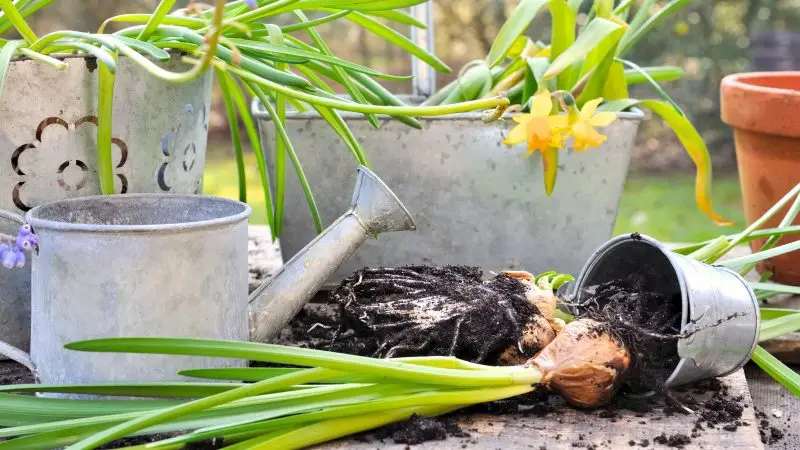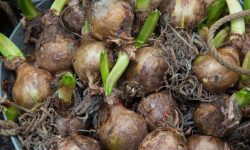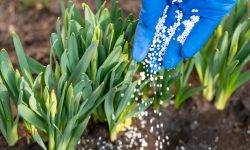Daffodils brighten gardens each spring with their golden trumpets and graceful leaves, but over time, their blooms can become fewer and smaller. Many gardeners wonder why once-vibrant daffodil beds lose their brilliance — the answer often lies beneath the soil. As bulbs multiply naturally, they grow crowded, competing for space, nutrients, and sunlight. When this happens, separating and replanting becomes essential to restore their vitality.
Knowing when and how to separate daffodils can transform your garden from dull to dazzling. Timing is crucial: divide too early, and bulbs may not recover; too late, and they’ll struggle to bloom the following year. This guide will show you exactly when to separate daffodils, how to do it safely, and how to care for them afterward to ensure bigger, healthier, and longer-lasting blooms in every new season.
Why Daffodils Need to Be Separated

Daffodils are among the most reliable and enduring spring flowers, returning year after year with minimal care. However, as the bulbs multiply underground, they begin to crowd each other. This natural process, known as clumping, reduces the amount of space, nutrients, and air each bulb receives. Over time, overcrowded bulbs compete for limited resources, leading to fewer blooms, smaller flowers, and weaker stems. Even in well-tended gardens, this gradual decline can go unnoticed until the once-vibrant patch becomes sparse and uneven. Separating the bulbs restores balance, giving each plant room to grow and thrive again.
When bulbs grow too close together, air circulation and soil drainage are restricted. This environment can trap excess moisture and lead to bulb rot or fungal diseases. Healthy daffodils depend on open space beneath the soil where roots can spread freely. By dividing the bulbs every three to five years, gardeners reduce disease risk and encourage stronger root systems. Proper separation also revitalizes the soil, as replanting loosens compacted ground and restores nutrient flow, resulting in healthier, more resilient plants.
Another reason to separate daffodils is rejuvenation. Like all perennials, daffodils benefit from periodic renewal to maintain peak performance. Dividing allows gardeners to propagate existing plants, spreading them to new areas of the garden or sharing them with others. Each division grows into a new cluster, ensuring a more abundant and balanced display of color. Regularly separating daffodils keeps them vigorous, disease-free, and capable of producing large, brilliant blooms that return reliably every spring.
When Is the Best Time to Separate Daffodils
Timing is everything when it comes to separating daffodils. The ideal time to divide bulbs is in late spring or early summer, after the flowers have faded and the foliage begins to turn yellow. At this stage, the bulbs have finished storing nutrients and entered a resting phase, which makes them easier to handle and less prone to damage. Attempting to separate them too early, while the leaves are still green, interrupts the energy transfer process and can result in poor blooming the following year. Waiting until dormancy begins ensures that the bulbs are fully recharged and ready for relocation.
In cooler climates, early summer typically offers the best conditions. The soil remains warm enough for bulbs to heal from division but not so hot that it stresses them. Gardeners should wait until the foliage has completely withered before digging. This yellowing is a clear signal that photosynthesis has ended and the bulbs have stored sufficient energy for next season’s growth. In warmer areas, such as the southern United States, dormancy may begin as early as late April, so timing should adjust accordingly. Monitoring local weather and soil temperature ensures optimal results.
Separating bulbs during dormancy also minimizes transplant shock and promotes strong regrowth. Handling bulbs gently during this time prevents root injury, and the dry soil allows easier digging without damaging the clumps. Dividing in fall or while shoots are active risks stunting growth and weakening the bulbs. By working with nature’s schedule — once leaves die back but before the ground hardens — gardeners ensure bulbs recover quickly, reestablish deep roots, and bloom with renewed vigor and brilliance the following spring.
How to Separate Daffodils Safely
Preparing the Soil and Tools
Before separating daffodils, preparation is key to success. Choose a dry, mild day when the soil is neither too wet nor compacted. Wet soil can cause clumps to stick together, making bulbs harder to remove cleanly. Start by trimming away any remaining flower stalks but leave the foliage intact until it yellows completely. Using a garden fork instead of a spade helps loosen the soil gently without slicing through bulbs. Work the fork around the clump in a wide circle, keeping at least six inches from the base of the leaves. Slowly lift the bulbs from beneath rather than pulling by the stems.
Prepare the new planting bed before digging up bulbs so they can be replanted immediately. The soil should be loose, crumbly, and enriched with compost or bone meal to promote strong root growth. Ensure the area gets full sun exposure, as daffodils need at least six hours of light daily. Lightly moisten the soil before planting to prevent transplant stress. By having the soil and tools ready, you minimize handling time and help bulbs recover faster, ensuring a healthier, more productive daffodil bed for years to come.
Lifting and Dividing the Bulbs
When lifting daffodil bulbs, take time to loosen the soil gently to avoid tearing roots. Insert the garden fork deeply, rocking it back and forth to lift the entire clump at once. Shake off loose soil and separate bulbs by hand, inspecting each carefully. Large, firm bulbs are perfect for replanting immediately, while smaller offsets can be grown separately until they reach maturity. Discard any soft, shriveled, or diseased bulbs to prevent fungal problems in the future. If the outer skins are damaged, allow bulbs to dry before replanting to toughen their surface.
After dividing, place the bulbs in a shaded, airy location for six to eight hours. This allows excess moisture to evaporate naturally, reducing the risk of mold. Avoid washing bulbs with water — gentle brushing is enough. If storing for later planting, keep them in mesh bags or paper sacks, never sealed containers, to maintain airflow. Labeling varieties ensures organized replanting later. This careful process preserves bulb health and ensures strong flowering. Dividing bulbs with patience and precision strengthens future growth, producing healthier plants and richer blooms the following spring.
Replanting and Watering After Division
Replanting daffodils promptly after division is vital for their recovery and future blooming. Choose a sunny spot with soil that drains well and has been enriched with compost or organic matter. Plant each bulb at a depth of about six inches — deeper in warm climates, slightly shallower in cold regions. Space bulbs four to six inches apart to give each one room to expand. Position them with their pointed ends up, then gently firm the soil around them to eliminate air pockets. Water thoroughly to settle the soil and encourage root establishment.
Over the next several weeks, keep the soil evenly moist but not soggy. In dry climates, mulching with shredded leaves or straw helps maintain moisture and regulates temperature. Avoid adding fertilizer immediately after planting; instead, wait until shoots appear to feed with a balanced, low-nitrogen blend. If replanting in late summer, ensure bulbs have at least four weeks before the ground freezes to root properly. Consistent moisture, light, and spacing allow bulbs to adapt quickly, ensuring strong foliage and spectacular blooms when spring returns.
Signs That Your Daffodils Need Dividing
One of the clearest signs that your daffodils need dividing is a noticeable decline in flower production. When daffodils become overcrowded, they compete for light, water, and nutrients, resulting in fewer or smaller blooms each spring. Clumps that once bloomed evenly across the garden may start producing scattered or misshapen flowers. In some cases, bulbs will stop blooming altogether, focusing their limited energy on leaf growth instead. This condition, known as “daffodil blindness,” is a strong indicator that the bulbs below have multiplied too much and now lack the space needed to thrive.
You may also notice stunted growth, weak stems, or leaves that yellow earlier than normal. Healthy daffodils should have tall, strong foliage that remains green for weeks after blooming. When bulbs are overcrowded, roots become entangled and compacted, preventing proper oxygen and nutrient flow. Over time, this stress can cause bulbs to shrink and rise closer to the soil’s surface. These exposed bulbs are more vulnerable to temperature swings, which can further reduce flowering. Soil that remains too dense or dry also accelerates the decline, especially if the same patch hasn’t been rejuvenated for several years.
Another clear signal that your daffodils need dividing is poor soil drainage or signs of bulb rot. When clumps remain untouched for too long, moisture builds up in compacted soil, creating a breeding ground for fungi and decay. The surrounding earth may even feel soggy or smell musty — both signs that airflow is restricted underground. By dividing the bulbs every three to five years, gardeners restore balance to the soil, encourage new root growth, and prevent disease spread. Regular division not only revives bloom quantity and size but also extends the life and health of each daffodil patch for many seasons ahead.
Caring for Daffodils After Division
Watering and Moisture Control
After dividing and replanting daffodils, proper watering is essential to help bulbs establish strong roots. Water the newly planted bulbs thoroughly to settle the soil and eliminate air pockets. For the first few weeks, maintain consistent moisture but avoid waterlogging, as soggy soil encourages bulb rot. In most climates, watering once or twice per week is sufficient if rainfall is limited. The goal is to keep the soil slightly damp at a depth of several inches. Mulching the bed with straw or shredded leaves helps retain moisture and regulate soil temperature.
As new roots form, gradually reduce watering to prevent fungal growth during dormancy. Well-drained soil is critical at this stage; clay-heavy areas should be amended with sand or compost for improved texture. In regions prone to drought, deep watering every ten days keeps bulbs hydrated without over-saturation. Avoid overhead watering, as constant leaf wetness can attract pests and fungal spores. Consistent yet balanced moisture management ensures daffodils establish securely and prepare for vigorous blooming in the next season.
Feeding and Nutrient Support
Nourishing daffodils after division helps bulbs recover from the stress of being lifted and replanted. About two to three weeks after replanting, when roots begin to form, apply a light feeding of low-nitrogen fertilizer such as 5-10-10. Nitrogen promotes excessive foliage growth, which can drain energy from bulb development. Instead, phosphorus and potassium encourage root establishment and flower formation for the following spring. Work the fertilizer lightly into the top few inches of soil, then water well to help nutrients absorb evenly.
Incorporating organic matter like compost or bone meal further enriches the soil and maintains long-term fertility. Avoid over-fertilizing, as this can cause soft, weak bulbs more prone to disease. Feeding once in late fall and again in early spring ensures daffodils have the nutrients needed for steady growth. Balanced nutrition supports recovery and strengthens bulbs, leading to more vibrant, longer-lasting blooms in future seasons. Healthy feeding habits are key to keeping divided daffodils productive for many years.
Monitoring Growth and Preventing Stress
After dividing and replanting daffodils, careful monitoring ensures a successful recovery. In the weeks following division, observe the planting area for signs of new growth, such as small green shoots or firm soil above the bulbs. Early signs of wilting or discoloration may indicate overwatering or poor drainage. If the soil feels overly compact, gently loosen the surface to enhance airflow. Consistent observation helps prevent small issues from becoming larger problems.
Protect newly divided bulbs from extreme weather conditions. In hot or dry climates, temporary shading can reduce stress during the first few weeks. In colder regions, mulch helps insulate the soil and protect bulbs from frost damage. If pests such as slugs or bulb flies appear, remove them promptly to avoid infestations. Keep the garden area weed-free to prevent competition for nutrients and water. By maintaining optimal growing conditions and checking plants regularly, gardeners ensure daffodils recover fully and reestablish strong roots for their next blooming cycle.
Common Mistakes to Avoid When Dividing Daffodils
Dividing Too Early or Too Late
Timing is one of the most critical factors in daffodil division, yet it’s also one of the most misunderstood. Dividing bulbs too early—when leaves are still green—disrupts the essential nutrient transfer from foliage to bulb. During this stage, daffodils are actively recharging energy reserves for the following season. Cutting or disturbing them too soon interrupts this process, leaving the bulbs weak and underdeveloped. These bulbs often struggle to bloom or produce smaller, distorted flowers the next year. Dividing too late is just as problematic. Once bulbs enter deep dormancy or the soil hardens in midsummer, their roots become fragile, and separating them risks breakage or rot.
The correct time to divide daffodils is after the foliage has fully yellowed but before the soil dries out completely. This window typically falls in late spring or early summer, depending on climate. Working within this natural rhythm allows the bulbs to heal quickly and reestablish roots before the next growing cycle. Timing division correctly ensures daffodils stay healthy, vigorous, and ready to produce abundant, high-quality blooms every spring without stress or decline.
Planting at the Wrong Depth
Planting depth directly determines how well daffodils perform after division. Many gardeners mistakenly plant bulbs too shallow, leaving them exposed to fluctuating temperatures and drought. Shallow bulbs dry out faster, sprout early, and often produce weak stems that fall over easily. In colder regions, they may even freeze during winter because they lack enough insulation from soil. Conversely, bulbs planted too deep struggle to emerge or expend too much energy pushing shoots upward, which limits flowering. Over several years, this imbalance can significantly reduce bloom size and quantity.
To achieve ideal results, plant bulbs about three times their height deep—typically six inches for most daffodil varieties. Measure from the bulb’s base to the soil surface for accuracy. For sandy or warmer soils, going slightly deeper offers added protection from heat. Firm the soil gently around the bulbs to remove air gaps and ensure stability. Always orient bulbs with their pointed tips facing upward for proper growth direction. Correct planting depth encourages balanced moisture, even flowering, and stronger bulb development that lasts for many years.
Ignoring Soil and Drainage Conditions
Soil quality and drainage are often overlooked but are fundamental to daffodil health. Many gardeners replant divided bulbs into compacted or clay-heavy soil without improving structure, causing poor aeration and water retention problems. Daffodil roots require loose, well-draining soil to expand freely and absorb nutrients efficiently. When water stagnates, oxygen cannot reach the roots, leading to fungal infections and bulb rot. Over time, poorly drained soil suffocates bulbs, stunts growth, and reduces flowering vigor. Repeated wet-dry cycles also harden the soil surface, worsening the issue further.
To prevent this, test your soil before replanting. Add compost, leaf mold, or coarse sand to improve texture and enhance drainage. For heavy clay soils, creating raised beds or planting on gentle slopes helps excess water drain naturally. Avoid low-lying areas that stay wet after rain. After amending, water deeply once to settle the soil and confirm proper drainage. Healthy, airy soil encourages robust root systems, disease resistance, and consistent blooms. Taking the time to correct drainage issues ensures daffodils thrive, producing radiant flowers that last season after season.
How Often Should You Divide Daffodils
Daffodils are resilient, but even the healthiest bulbs eventually need space to grow. On average, gardeners should divide daffodils every three to five years, depending on how quickly the clumps expand. In ideal soil and sunlight conditions, bulbs multiply rapidly underground, forming dense clusters. When this happens, airflow decreases, and nutrient competition increases, leading to smaller or fewer blooms. Observing your daffodils annually helps determine the right time to divide. If flower quantity drops or leaves appear thinner and weaker, it’s time to rejuvenate the bed.
In cooler climates, daffodils often need division less frequently since growth slows during long winters. In warmer or wetter regions, however, bulbs multiply faster due to extended growing periods, meaning division may be necessary every two to three years. The condition of the soil also plays a role — heavy or compacted soil accelerates crowding, while loose, fertile soil allows bulbs to thrive longer without intervention. Adapting to your region’s environment ensures more predictable bloom cycles.
When dividing too frequently, bulbs can become stressed and take longer to recover, so balance is essential. Observing both the surface foliage and underground density provides the best timing cues. Ideally, plan bulb division right after blooming ends, once foliage yellows naturally. This cycle keeps your garden vibrant and maintains consistent flower quality year after year, ensuring healthy bulbs that deliver reliable color every spring.
Benefits of Dividing Daffodils Regularly
Regular division of daffodils does more than restore their blooming power — it revitalizes the entire garden ecosystem. When bulbs are given room to breathe, they absorb nutrients more efficiently and produce stronger roots. Dividing also prevents diseases caused by overcrowding, such as bulb rot or fungal infections, which spread quickly in dense clumps. Healthier soil results from the process as well, since replanting loosens compacted areas and reintroduces air circulation. Over time, this promotes a balanced environment where microorganisms can thrive and improve soil fertility naturally.
Another major benefit of dividing daffodils is propagation. Each time you separate bulbs, you effectively multiply your collection without needing to purchase new ones. Smaller offsets grow into mature bulbs within a few seasons, filling garden gaps or creating new flower beds. Dividing also allows gardeners to rearrange daffodil varieties for better color composition and landscape design. Regular maintenance ensures a longer blooming period, larger flower heads, and a consistent display of healthy foliage.
Dividing daffodils every few years is an act of renewal — it preserves vitality, prevents decline, and rewards gardeners with brighter, more uniform blooms. Beyond aesthetics, it fosters sustainability, helping your daffodils flourish naturally for decades. With routine division, your spring garden remains full of life, fragrance, and golden brilliance season after season.
FAQs About Separating Daffodils
How often should I separate daffodils?
Daffodils should be divided every three to five years, depending on growth and blooming performance. If flowers become fewer or smaller, it’s time to lift and separate the bulbs. Regular division improves air circulation, prevents overcrowding, and restores nutrients, ensuring strong growth and vibrant blooms each spring.
Can I separate daffodils in the fall?
While daffodils can survive fall division, it’s not ideal. Late spring or early summer—after the foliage yellows—is the best time. During this period, bulbs are dormant and less likely to suffer transplant shock. Fall division can stress the bulbs and delay blooming the following season.
What should I do with small daffodil bulbs after dividing?
Small or immature bulbs, often called offsets, can be replanted in a separate bed to mature. Give them two to three years before expecting blooms. Ensure proper spacing, sunlight, and watering. With consistent care, these smaller bulbs will grow stronger and produce full flowers in future seasons.
How deep should I replant daffodil bulbs after separating?
Replant bulbs about three times their height—usually six inches deep for standard daffodils. Plant too shallow, and bulbs may dry out or sprout early. Too deep, and blooms may weaken. The ideal depth stabilizes bulbs, protects them from frost, and ensures even, healthy flowering.
Why did my daffodils stop blooming after dividing?
If daffodils fail to bloom after division, they may have been separated too early or replanted incorrectly. Ensure bulbs were divided after foliage yellowed, planted at the correct depth, and placed in full sunlight. With proper watering and post-bloom care, they will recover and bloom beautifully the next spring.
Conclusion: Keeping Daffodils Blooming Beautifully Year After Year
Caring for daffodils and dividing them at the right time ensures their beauty never fades. By understanding when to separate, how to replant, and how to nurture them through each season, gardeners preserve the strength and grace of these timeless flowers. Regular division rejuvenates the bulbs, enriches the soil, and promises brighter, fuller blooms with every spring. Daffodils are more than garden ornaments — they’re symbols of renewal and resilience, returning year after year to remind us that with patience and proper care, beauty always finds its way back to life.






